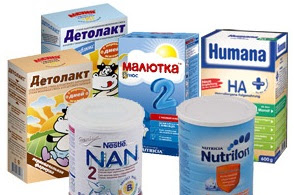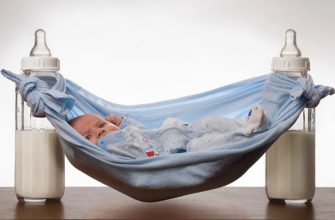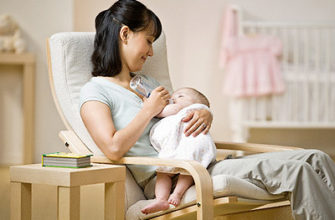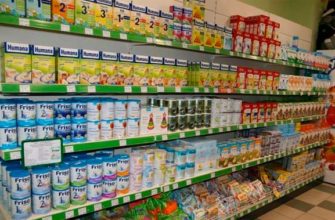All young mothers are well aware that in the first months of life there is no more wholesome food than breast milk for a newborn baby. But sometimes a situation arises in which there is a need to transfer the baby to another diet (there is no breast milk or mother cannot breastfeed). Artificial feeding of a newborn child requires the right approach to the choice of mixture and to following a new diet. Consultation with a pediatrician is a prerequisite before starting IV.

Indications for switching to IV
Feeding with even the highest quality mixtures will not be able to replenish those microelements that the baby receives with his mother’s milk. Therefore, the introduction of adapted nutrition should always be justified. Pediatricians highlight several circumstances when artificial feeding is considered necessary:
- Severe labor, after which the mother must restore her strength;
- Taking certain groups of essential drugs by a woman;
- Infectious diseases of the mother;
- Lack of milk in the glands of the breast or its insufficiency. The lack of milk is determined by the control weighing of the baby after feeding;
- Inability to feed the baby due to temporary absence. This testimony is justified when there are no conditions for the storage of expressed milk or the period of absence of a mother is calculated in weeks.
Inadequate milk production must first be restored with drugs that enhance lactation. They begin to carry out artificial feeding of the child only if these drugs do not bring the expected result. It is not necessary to introduce the mixture completely immediately, even a few grams of breast milk are useful for the baby's body and it is impossible to deprive him of this benefit.
Pros and cons of using artificial mixtures
 Not all young mothers seriously think about what awaits them and the baby when switching to the use of infant formula. Often, only because of her convenience, a woman deprives a child of the necessary trace elements for his immunity and general health. Before deciding to switch to IV with the recommended pediatrician mixture, you need to weigh all the advantages and disadvantages of the new diet. The obvious advantages of artificial feeding a child include:
Not all young mothers seriously think about what awaits them and the baby when switching to the use of infant formula. Often, only because of her convenience, a woman deprives a child of the necessary trace elements for his immunity and general health. Before deciding to switch to IV with the recommended pediatrician mixture, you need to weigh all the advantages and disadvantages of the new diet. The obvious advantages of artificial feeding a child include:
- The possibility of feeding the baby to other relatives. That is, mom can calmly go away on her business and not worry that the baby will cry from hunger;
- When feeding a baby from a bottle, mother always knows how much he eats at a time and, if there are problems with well-being, immediately notices this by the amount of food left;
- Appearance allergies always associated with the type of mixture.In order to determine the allergen in a baby while breastfeeding, a nursing mother has to completely review her diet;
- The mixture is digested longer than milk, so the number of meals a baby is reduced.
These are some of the benefits of formula feeding, but there are much more minuses:
- Artists often get colds, allergies in subsequent years. This fact is explained by the absence in their body of special enzymes that the baby can get only from mother's milk;
- The use of bottles requires constant sterility. If cleanliness is not observed, then dyspeptic disorders may develop;
- Babies fed with mixtures often suffer from colic and periodic regurgitation - a poor-quality nipple helps to swallow air;
- When traveling with a child, you have to take a separate bag with a mixture, bottles, sterilizers, that is, excess baggage;
- Often you have to change several types of mixtures in order to find the most suitable;
- Artificial feeding of a child involves certain financial costs. A good mixture can not be cheap, but as a child grows older, it is required more and more times.
How to choose a mixture
The selection of the mixture must be agreed with the pediatrician. The doctor knows the features of your child’s health and advises on the most sparing nutrition. It is necessary and independently to pay increased attention to the choice of mixtures and be sure to observe the following criteria:
- Shelf life - The most important condition for the absence of adverse reactions. Choose those boxes where there is a margin in use time of several months;
- Packaging must not be opened or deformed. The presence of dents, scratches indicates non-compliance with the conditions of transportation, and such a mixture may be damaged;
- Meals are made by age category. You can not give a newborn a mixture intended for older children, an unformed stomach and intestines can respond to serious diseases;
- You need to teach your baby with the introduction of hypoallergenic mixtures;
- If a child has certain health problems, then the food may contain supplements that are useful for improving the functioning of the organs. Mixtures may contain herbs to enhance immunity, iron to treat anemia.
We read a detailed article: How and which mixture is better to choose >>>
How to cook food
When artificially feeding a child, his well-being will directly depend on how you prepare the mixture. The instructions must be read and follow its points must be.
- For breeding, it is best to use special bottled water, when boiling part of the nutrients is lost. If water is taken from a tap, then boiling it is necessary;
- The dosage must be fully observed. Excess amount of dry mix or lack of water can lead to a glut of the intestines with nutrients, and this is reflected in colic, dyspeptic disorders. The lack of a dry base leads to the fact that the baby is naughty, asks for a bottle out of time;
- The mixture is diluted directly in a bottle, where water is preliminarily poured with a temperature not exceeding 50 degrees. Higher temperatures destroy beneficial bacteria;
- After dilution, the mixture is shaken and made sure that there are no lumps. Before feeding, check the temperature - it should not be above 37 degrees;
- The hole in the nipple should be such that the baby adjusts certain efforts to sucking. Leaking in a thin stream leads to a complete rejection of the chest and to the fact that the stomach begins to quickly stretch.
[sc: rsa]
Video instruction:
How to feed a baby
Children fed with mixtures often weigh much more than their peers who use their mother’s milk. This is not as good as it seems, with increased obesity there are a variety of health problems. To avoid this, you don’t need to overfeed the baby, you must take into account how much he drinks and how long it can go without a bottle.
- The bottle is chosen when the baby is fully fed with mixtures or their number reaches 2/3 of the total supply. The nipple must be with a narrow hole, this will not allow the baby to wean from the chest (how to choose a bottle for food);
- A teaspoon is used when the child feeds mainly on the breast, and receives the missing amount of food in the form of mixtures;
- Sometimes a child refuses both a bottle and a spoon, but you need to feed him. In this case, the diluted mixture is poured through a syringe without a needle in small doses.
Feeding technique
- The baby should be in an almost vertical position, it is convenient for sucking and will not allow to choke.
- Make sure that milk completely covers the nipple, and air accumulates at the bottom of the bottle. This will prevent air from entering the stomach.
- After feeding the baby, you need to hold it in an upright position so that the trapped air comes out.
We read:How to teach a child a bottle
Rules and Tips

If you feed your baby with mixtures, this does not mean that you need to leave him alone. The baby may be choked with milk or lose a bottle. The emotional contact of the mother with the baby is also important, therefore, holding it in your hands you can calmly watch the concentrated face of the crumbs and relax from household chores.
The pacifier on the bottle needs to be changed periodically, it quickly thins, and the mixture pours through the hole in a continuous stream. You should always use the mixture after cooking or store it in the refrigerator. Leftover food spills out right away.
The kid “artificer” needs more early use of complementary foods, this will make up for the deficiency of missing trace elements.
How much milk formula should a baby eat:
How to calculate the right amount:
Frequency of sterilization of the bottle and nipples for feeding:
In the first month of life, all bottles and nipples need to be sterilized after each feeding. First, the remaining mixture is removed with warm water and a brush, then all devices are boiled for 10 minutes. It is best to purchase a special sterilizer, using it, you will always be sure of the cleanliness of the dishes.
After the first month of life, it is enough to rinse the nipple and bottle and rinse them with boiling water. But still, make sure that the bottles are thoroughly washed, special attention should be paid to carving, inaccessible places in which bacteria can multiply in a few hours.
Is it possible to store the prepared mixture:
The prepared mixture is stored at room temperature for no more than 2 hours, in the refrigerator no more than 12 hours. The remaining residues of the mixture after feeding are poured, the use of such milk in an hour can lead to poisoning.
Video: Proper Bottle Feeding
Free IW
The need for food for the baby at different times of the day is not the same. But still, it is necessary to adhere to a certain schedule with a half-hour deviation in one direction or another.So you will always know what time the baby usually eats and you can predict the time of the visit to the clinic or for a walk. In compliance with the regimen, the baby falls asleep easier and is less prone to excessive weight gain,
Situations in which replacement of the mixture is necessary:
- The mixture does not fit, causes frequent spitting updiarrhea or constipation, allergic reactions;
- Reaching a certain age. A baby of 6 months does not make sense to give a mixture for newborns;
- The need to use special medicinal nutrition.
Problems of artificial feeding:
Artificial feeding of a child is considered in medicine as "metabolic stress" and therefore causes a wide variety of reactions. Allergies, stool problems, colic occur in the first days of most babies. Some of them get used to it, others have to change the mixture.









I am a supporter of exclusive breastfeeding. However, when I was cut out appendicitis and my daughter was on HB, I had to switch to artificial temporarily. There were no problems, she easily began to eat the mixture and two weeks later, when I returned, she took her breasts perfectly, I think that it is better not to be lazy in the GV case.
I lost milk when my son was not even two months old. After switching to artificial feeding, the only thing I saw the positive side was that the child's stool returned to normal almost immediately.
For me, night feeding was a significant disadvantage in artificial feeding. I remember with horror when I walked up 5 times a night to get up to prepare a fresh mixture. While with natural feeding, I could simply put crumbs on my chest, and not run around at night to the kitchen.
Besides the fact that it is necessary to prepare the mixture, so then I also had to wash a bunch of bottles. The sterilizer helped me insanely. Before buying a sterilizer, I spent a long time browsing the Internet, read a lot of reviews and decided to stay on the chikko sterilizer. This is simply an indispensable thing in the house, especially if your baby is on artificial feeding. He saves a lot of time. The sterilizer was liked both in appearance and in ease of use, and the price is not high (compared to other companies). Roomy enough, which is extremely important, because I have twins, and a day I have to sterilize a lot of bottles, nipples and soothers. Easy to use, just press a button and after a few minutes everything is sterile. And what is very important - he disconnects himself. Turned on and forgot. The plastic of which the sterilizer is made is pleasant to the touch and durable (it fell a couple of times on the floor and there are no cracks and everything works).Despite its spaciousness, it is very compact and does not take up much space. I am very pleased with my purchase. And I advise everyone that you will definitely not regret this purchase.
Of course, if there is breast milk and it is enough, then you need to forget about the mixtures, why? But if there is no milk or it’s gone, then there’s nowhere to go ... (My son had a food allergy to many mixtures, which we just didn’t try ... and NAS and Nutrilon. Our pediatrician muttered, we need probiotics, we need probiotics, try .... the doctor, of course, is still the one ... We went to the nuppy standard, came up to us. And the most important thing was that our pediatrician calmed down - there are probiotics there)))) As for washing the bottles, I agree with you Evgeny ... I first boiled for 10-15 minutes, naturally after each kormeshki, and then also bought a sterilizer, it became easier)))
Lack of breast milk, unfortunately, is not a rare occurrence. And it's good that there is a large selection of mixtures for the baby. I buy my own mixture in goat milk Goat, because it is closest to mother's milk. And the allergy does not cause as much as it does from cow's milk. Everything is ok with this business - there is no allergy in the child, no problems with the assimilation of the mixture.
My girl on IV from the third week after birth. And to whom, if not to me, how much time does she freely endure without feeding. 4 hours between feedings withstands freely, while ate 5 times a day - 200g. mixture, in its 6 months, height - 82cm, weight - 9400g - well, not at all small! At night, she also sleeps calmly for 7-8 hours and there is nothing surprising in this, since the mixture is really fuller than breast milk. I give Materna, the best food that we tried, took in baby1care. And colic almost did not bother her. You can not compare children on the IW with children on the GV, or rather you can compare, but the difference is huge.